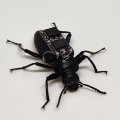Further advances in genetics and research have the potential to increase the Australian lucerne production area 20-fold, according to 2006 Farrer Memorial Medal recipient, Professor John Irwin.
Professor Irwin, who delivered his Farrer Medal oration at The University of Queensland on Thursday, September 21, said the breeding of superior lucerne varieties, combined with a greater knowledge of diseases which affected the forage legume, had already led to increased production levels across eastern Australia.
The leading agricultural scientist and academic from UQ`s School of Integrative Biology, gave his oration after receiving the prestigious medal from NSW Department of Primary Industries Director-General and Farrer Memorial Trust Chairman, Barry Buffier.
“Lucerne is Australia’s most important perennial forage legume with over 200,000 hectares grown for hay production, and 3.5 million hectares used in ley farming operations,” Professor Irwin said.
“But modelling indicates the potential area that could be sown to lucerne in Australia could be around 81 million hectares.”
Professor Irwin said yield stagnation had been an issue worldwide as no advances had been made in yield per se, largely due to the current methodologies for breeding lucerne remaining unchanged for the last 60 years.
Most of the increases made so far have come from the incorporation of disease and pest-resistance.
But Professor Irwin said recent advancements in hybridising lucerne with another species called Medicago arborea had the potential to lead to significant yield increases.
Hybrids made with yellow flowered Medicago falcata also showed good yield increases at Gatton, Queensland and resistance to Stagonospora crown rot would greatly benefit lucerne in southern Australia.
“Up until 1977, the Hunter River variety comprised more than 95% of the lucerne area in Australia,” Professor Irwin said.
“But since then, cultivars with multiple disease and pest resistance have been bred in Australia and this has resulted in at least 20%-30% higher irrigated hay yields on average across the country.”
The Farrer Memorial Medal is awarded annually to a person who has provided distinguished service in agricultural science in the areas of research, education, extension or administration.
Mr Buffier said the medal recognised the significant contribution Professor Irwin had made to the field of agricultural research, and in particular his efforts in reducing risk of disease in tropical plants.
.jpg)


